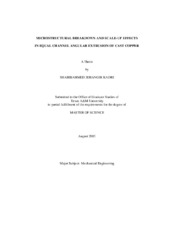| dc.description.abstract | The primary objectives of this study were: (1) to verify the effectiveness of ECAE
to induce equal amounts of strain and grain refinement in bars of different cross-sectional
areas, (2) to determine the effectiveness of ECAE in breaking down the as-cast
macrostructure in CDA 101 Cu and in producing a homogeneous material containing
micron-scale grains upon recrystallization, and (3) to determine a thermomechanical
processing (TMP) schedule (from the ones examined) that produces the best
microstructure in terms of grain size and uniformity. The effects of extrus ion route, levels
of strain and intermediate heat treatment were investigated.
To achieve the first objective, bars having square cross-sections of three different
sizes, 19 mm, 25 mm and 50 mm, were processed up to eight ECAE passes through
routes A, B, C and E. To achieve the second and third objectives, bars were processed up
to eight ECAE passes with and without intermediate heat treatments through routes Bc,
C, E and F. ECAE processing was carried out in a 90o extrusion die with sliding walls at
an extrusion speed of 2.5 mm/s. Recrystallization studies were carried out on the
processed material to evaluate the recrystallization behavior and thermal stability of the
material. The as-worked and recrystallized materials were characterized by Vickers
microhardness, optical microscopy (OM) and transmission electron microscopy (TEM).
Results indicate that similar hardness values, sub-grain morphology and
recrystallized grain size are generated in the three bars having different cross-sectional
sizes processed through ECAE. ECAE is shown to induce uniform strain in all three billet
sizes. ECAE is therefore shown to be effective in scale-up to a size of at least 50 mm,
with larger billets giving better load efficiency. Results from the later parts of this study indicate that eight extrusion passes via
route Bc produces the best microstructure in terms of grain size and microstructural
uniformity. The routes can be arranged in the sequence Bc> E, F> C for their ability to
produce a uniform recrystallized microstructure with small average grain size.
Macroscopic shear bands are sometimes generated during extrusion depending upon the
initial grain morphology and texture of the material. | en |


